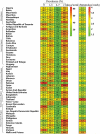Fast food consumption among young adolescents aged 12-15 years in 54 low- and middle-income countries
- PMID: 32762333
- PMCID: PMC7480506
- DOI: 10.1080/16549716.2020.1795438
Fast food consumption among young adolescents aged 12-15 years in 54 low- and middle-income countries
Abstract
Background: Most countries worldwide, especially low- and middle-income countries (LMICs), are facing an increasing prevalence of fast-food consumption and multiple burdens of malnutrition among young adolescents.
Objective: To compare the prevalence of fast-food consumption among young adolescents in LMICs.
Methods: We used data from the most recent Global School-Based Student Health Survey (2009-2015), which had been collected using a standardized questionnaire. The weighted prevalence and 95% confidential intervals of fast-food consumption were calculated overall and in subgroups stratified by age, sex, and nutritional status. The pooled overall and regional estimates were obtained using a random-effects model. Heterogeneity was assessed using the I2 statistic. The associated risk factors for fast-food consumption were explored using logistic regression analysis.
Results: Our study comprised 153,496 young adolescents (46.90% boys) from 54 LMICs. Overall, approximately 55.2% (51.3-59.1%) of the adolescents consumed fast food at least 1 day per week, and 10.3% (8.3-12.4%) did so 4-7 days per week. The prevalence of fast-food consumption 4-7 days per week was lowest in the Americas (8.3%; 6.7-9.9%) and highest in Southeast Asia (17.7%; 2.3-33.2%). At a country level, the prevalence was lowest in Pakistan (1.5%; 1.0-2.0%) and highest in Thailand (43.3%; 40.4-46.1%). Furthermore, in subgroups stratified by nutritional status, the prevalence was lowest in the obesity group (6.6%; 4.5-8.7%). Factors such as age, sex, BMI, food insecurity, fruit consumption, vegetable consumption, soft-drink consumption, smoking, physical activity level, and sedentary behavior level were found to be correlated with fast-food consumption.
Conclusions: The identified high prevalence of fast-food consumption among young adolescents in LMICs indicates the urgent need to prioritize the implementation of healthy-diet promotion programs to improve adolescent health in these countries.
Keywords: Fast food; GSHS; adolescents; low- and middle-income countries.
Conflict of interest statement
The authors declare that they have no competing interests.
Figures
References
-
- Jaworowska A, Blackham T, Davies IG, et al. Nutritional challenges and health implications of takeaway and fast food. Nutr Rev. 2013;71:310–318. - PubMed
Publication types
MeSH terms
LinkOut - more resources
Full Text Sources

